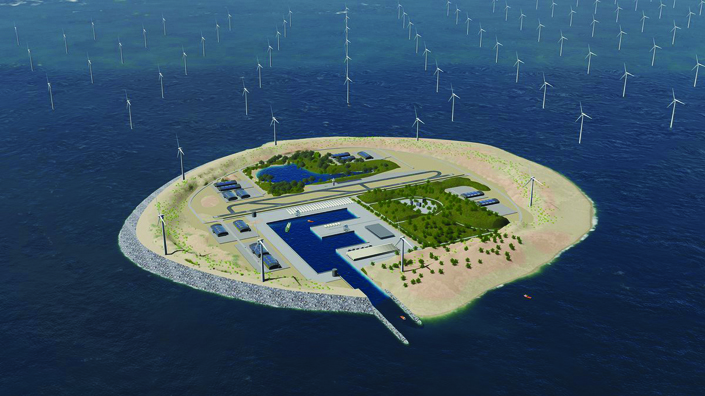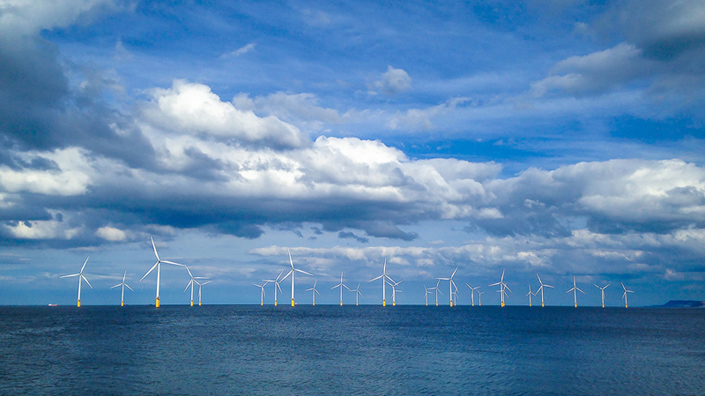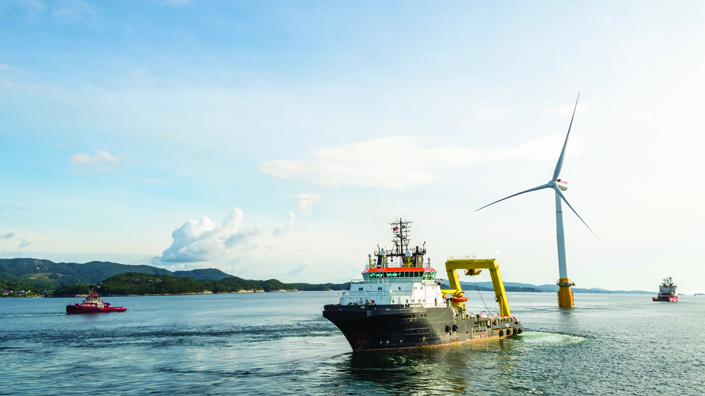When Sheikh Zayed bin Sultan Al Nahyan came into the world 100 years ago, the United Arab Emirates (UAE) did not exist. In the undeveloped emirate of Abu Dhabi, people fished and dived for pearls, while in neighbouring Dubai Bedouins grew dates and bred camels.
By the time the sheikh died in 2004, skyscrapers towered over the desert. Rapid growth came after the first oil exports in 1962, and the sheikh united the UAE’s seven states under his rule in 1971.
Now the world’s tallest building, the Burj Khalifa in Dubai, is a symbol of the country’s success in the fossil-fuel era. Oil and liquid natural gas flow into the surrounding region and across Asia to countries such as Japan, India and China as the UAE celebrates the Year of Zayed.
But, decades after black gold first burst from the sand, the desert is changing colour once again – dusty orange gives way to oceans of deep blue as vast rows of solar panels spread. Fifty-six years after first feeding the world with petroleum, the UAE is embracing the renewables revolution.
The Mohammed bin Rashid Al Maktoum (MBR) Solar Park in Dubai will be the world’s biggest single-site solar farm, with a planned total capacity of 5,000MW. In Abu Dhabi, energy company Masdar claims its Shams 1 concentrated solar power (CSP) plant is the largest operating renewable energy project in the region.
Beyond the Arabian Peninsula, governments and companies are planning the largest renewable energy projects ever seen. While solar panels tap the energy of the sun, huge windfarms provide more power every year – the world’s energy mix is changing, driven by constant innovation.
Giant projects
The first things that reveal the MBR’s scale are the buses grouped in the dusty car park. After a long journey through the warm, empty desert, the US-style yellow school bus grabs my attention. Next to it, a battered, once-white coach is already packed with men from the Indian subcontinent, chatting and listening to music. Other workers run from the park’s gates to get the best seats on the next shuttle home, while more creaking vehicles arrive.
A better view of the solar farm appears from the top of a two-storey prefabricated block. As I look out of the window in the fading light, the rows of Canadian Solar silicon solar modules form a smooth surface stretching to the horizon. In another direction, yet more rows of metal frames sit waiting for the thousands of construction workers to install new panels.
![file3[1] The view over the MBR solar park](https://imechewebresources.blob.core.windows.net/imeche-web-content/images/default-source/default-album/file3-1.jpg?sfvrsn=e276ba12_0)
The view over the MBR solar park (Credit: Joseph Flaig)
The huge project, which will include a 1,000MW tower-style CSP installation alongside the 4,000MW capacity photovoltaic cells, plays a big part in Dubai’s renewable energy goals. In 12 years’ time, the emirate aims to increase its share of ‘clean energy’ – nuclear included – from 7% to 25%. By 2050, the goal is 75%.
The scale of the solar park is massive – the Dubai government hopes it will reduce carbon emissions by 6.5m tonnes a year after a total investment of £10bn. But it is just one of many mammoth new renewables projects which would have been unthinkable just 10 years ago.
Dogger Bank
About 100km off the east coast of England, something strange happens in the North Sea. After depths of about 100m, the seafloor rises up and the water suddenly becomes much shallower – only 15-36m deep. The shallow area, a large sandbank known as Dogger Bank, could house the world’s most ambitious renewable energy project. A consortium of operator TenneT, Danish enterprise Energinet, Dutch gas company Gasunie and the Port of Rotterdam hopes to build three islands in the shallow water, serving vast wind-turbine arrays.
The site is suitable, says the group, because on-shore electricity converters on artificial islands would be cheaper than turbine-mounted converters. The installation, which would be built between 2030 and 2050, could potentially provide 100GW of power to surrounding North Sea countries, enough for many millions of homes.
“This is a huge vision,” says TenneT spokesman Mathias Fischer. It could be, he adds, “a serious way to cope with the CO2 reduction and the implementation of renewables in the size that the Paris climate-change agreement demands until 2050... TenneT thought, ‘How big can a wind park be, and where can it be done?’.”
The Dogger Bank concept is undeniably ambitious, but the heavyweight consortium’s vision reveals the increasing scope of renewables projects. As 2050 approaches, big business is finally seeing their potential after dramatic cost reductions.

A concept image showing one of the potential new islands (Credit: TenneT)
For photovoltaic (PV) solar power, the difference is huge, says Hossein Mirzaii, director of Kingston University’s renewable energy engineering course, who became involved with the sector in the 1980s. “When you look at PV, the price was $77 per peak watt; now we are looking at 2016 figures of 30¢ per peak watt. That is a staggering reduction.”
Wind power is also more accessible now, with investors confident in the sector’s future. “Offshore wind is now seen as relatively mature in terms of technology and has become mainstream. The investment community is less wary,” says Feargal Brennan, director of energy and power at Cranfield University’s Offshore Renewable Energy Engineering Centre.
The global downturn in the oil and gas market has further encouraged fossil-fuel-rich countries such as the UAE and Saudi Arabia to embrace new technologies, as highlighted at the Abu Dhabi Sustainability Week last month. Tiny companies from Europe, the US and Asia sat alongside giants such as Siemens and Masdar, and representatives of governments and organisations preached the many benefits of large renewables projects.
“Renewable electricity becomes cheaper with scale,” said Adnan Z Amin, director-general of the International Renewable Energy Agency (Irena). “This has had a tremendous impact on the thinking of energy planners across these regions, because the availability of resource potential in all of these areas is tremendous – whether it is geothermal, or solar, or hydro or wind.”
Bigger and better
One of the main drivers of lower costs, increased confidence and bigger projects is innovation. After years of development, today’s PV panels and wind turbines are better than ever before.
“The new generations of windmills are bigger and bigger, they produce more megawatts,” says Fischer. “Now we already have 10MW and more, and a few years ago it was only 3.6MW and less. We expect techniques to be more and more efficient when we are approaching the 2030s.”
Efficiency largely comes down to the size of new turbines – they are the “largest moving machines on the planet,” says Brennan. Some now have blade diameters of more than 160m, putting far greater stress on components than on onshore models but reaping the rewards in electricity generation.

(Credit: iStock)
“In terms of the drivetrains, the gearboxes and so on, these have been completely re-engineered and redesigned,” he says. “We’ve got very competitive, very advanced machine solutions.” New windmills are filled with sensors, gathering vast pools of operational data to feed into research and development for further innovations.
Manufacturing advances have likewise created better PV cells. Many solar panels now include multiple semiconductor materials, each suited to absorbing different wavelengths of light to massively improve efficiency.
Nanotechnology can further boost energy generation. Kingston University’s Mirzaii and researcher Sanhapat Kanlayasiri coated panels with ultra-thin – 5-10µm – nanoShell protector, a hydrophobic layer that stopped particles from settling, finding efficiency gains of 5%.
Enter the robots
Other supplementary technologies such as solar trackers are also enabling much larger projects by improving efficiency and increasing automation, minimising human risks and costs. Robotic cleaning systems that traverse rows of solar panels once or twice a week, removing dust or bird droppings, are “almost de rigueur” as operators seek to minimise losses, says Mark Kingsley, president of equipment supplier Alion Energy.
The solar trend is mirrored in wind, where companies increasingly use drones for inspecting the giant new turbines, and robotic maintenance of the inaccessible machines is likely to follow.
Installation will become more automated with the advent of large-scale floating windfarms. Unlike normal offshore installations, floating turbines are not driven into the ground, and instead balance on submerged structures. The technology, successfully rolled out in Statoil and Masdar’s 30MW Hywind Scotland project, is therefore much easier to install and could open up vast and previously inaccessible areas to wind power.
“Floating is the way forward,” says Brennan. “Health and safety is really important, and floating allows us to assemble whole units close to shore and float them out as an integral unit, so minimising human interventions and human operation. We are going to see big, big developments in floating – not just individual platforms, but floating arrays, and they may allow us to look at completely different types of turbine.”

A floating turbine looms over an installation ship at Hywind Scotland (Credit: Statoil/Øyvind Gravås)
Ease of assembly and installation could also slash costs, says Irena director Amin, potentially reducing already competitive prices by 50-60%. “It is going to be a game-changer, and it can be deployed in more and more places,” he tells PE. “We know there are places where it is extremely costly and not possible to deploy offshore wind because of the depth of the continental shelf and there are all kinds of engineering challenges there. But if these experiments start to yield very positive results, which we expect them to, in the next couple of years we will see what the potential for these is.”
Macro to micro
As solar farms spread across the desert like vast new oases, engineers plan artificial islands with monumental wind installations and fresh innovations constantly open new areas to energy harvesting, it might seem that the renewable future is simply one of mammoth scale.
While operators are undeniably launching the biggest projects ever seen, a recent phenomenon at the other end of the scale constantly comes up in expert discussions – “micro-grid systems are the things of the future,” says Kingston University’s Mirzaii.
People in countries around the world are installing turbines and solar panels, trading energy with neighbours and reducing their reliance on national grids. Advanced electronic control systems are managing energy flow, even feeding back to the grid during blazing sun or strong winds. With falling maintenance costs, better storage and blockchain-based trading, many agree that micro-grids will power more and more homes in coming years.
“Decentralised energy has become a big phenomenon,” says Amin. “What we have seen in the last year is that big European utilities have lost huge amounts of money because they have underestimated what is happening.”
Small countries with limited resources also see decentralised systems as an easy way of powering citizens’ homes. Last month, Bahrain approved residential rooftop solar installations for the first time, reducing dependence on the gas-fed national grid.
“This is breaking the monopoly,” said Bahrain’s electricity minister Abdul Hussain bin Ali Mirza at Abu Dhabi Sustainability Week. “Before two weeks ago, nobody in Bahrain could produce and sell electricity except the government, so for the first time there is a breakthrough.”
Future of fuel?
Despite infectious optimism for renewables around the globe, fossil fuels are not yet finished. Coal power stations still burn, petrol cars will be on the road for decades to come, and the US president has called climate change a Chinese hoax. A Siemens report predicts that gas power will keep its huge 60% share of the Middle East energy market until at least 2035 despite the new projects in the UAE and elsewhere.
But with Arctic ice melting and global temperatures breaking new records every year, it is clear that governments and operators must embrace the latest engineering innovations for further progress on the biggest and very small scales.
“It is great for our economies but we really also have this incredible climate change imperative,” said Nick Bridge, the UK government’s special representative for climate change, in Abu Dhabi. “We are doing amazing things but the science is increasingly alarming – so it is fantastic, but we need to go faster.”
Content published by Professional Engineering does not necessarily represent the views of the Institution of Mechanical Engineers.